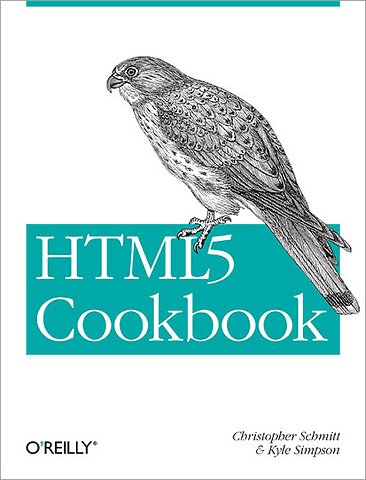


Christopher Schmitt is the founder of Heat Vision, a small new media publishing and design firm, based in Cincinnati, OH.
Meer over de auteursHTML5 Cookbook
Solutions & Examples for HTML5 Developers
Paperback Engels 2012 1e druk 9781449396794Samenvatting
With scores of practical recipes you can use in your projects right away, this cookbook helps you gain hands-on experience with HTML5's versatile collection of elements. You get clear solutions for handling issues with everything from markup semantics, web forms, and audio and video elements to related technologies such as geolocation and rich JavaScript APIs.
Each informative recipe includes sample code and a detailed discussion on why and how the solution works. Perfect for intermediate to advanced web and mobile web developers, this handy book lets you choose the HTML5 features that work for you-and helps you experiment with the rest.
- Test browsers for HTML5 support, and use techniques for applying unsupported features
- Discover how HTML5 makes web form implementation much simpler
- Overcome challenges for implementing native audio and video elements
- Learn techniques for using HTML5 with ARIA accessibility guidelines
- Explore examples that cover using geolocation data in your applications
- Draw images, use transparencies, add gradients and patterns, and more with Canvas
- Bring HTML5 features to life with a variety of advanced JavaScript APIs
Specificaties
Lezersrecensies
Inhoudsopgave
1. Fundamental Syntax and Semantics
-Introduction
-Specifying the DOCTYPE
-Specifying the Character Set
-Specifying the Language
-Optimizing SCRIPTs and <link>s
-Adding Document Structure with HTML5's New Elements
-Choosing Between <article> and <section>
-Checking Your Document Outline
-Modifying the Document Outline
-Emphasizing Text
-Adding Importance to Text
-Highlighting Text for Reference
-Marking Up Small Print
-Defining Acronyms and Abbreviations
-Adding Links to Block-Level Content
-Marking Up Figures and Captions
-Marking Up Dates and Times
-Setting the Stage for Native Expanding and Collapsing
-Controlling the Numbering of Your Lists
-Hiding Content to Show Later
-Making Portions of a Page Editable
-Setting the Stage for Native Drag-and-Drop
2. Progressive Markup and Techniques
-Introduction
-Adding More Semantic Meaning
-Picking a Markup Style
-Understanding Browser Support for HTML5
-Making Internet Explorer Recognize HTML5 Elements
-Detecting HTML5 Features with JavaScript
-Using HTML5 Boilerplate
-Validating HTML5
-Mapping HTML5 Elements to ID and Class Names
3. Forms
-Introduction
-Displaying a Search Input Field
-Contact Information Input Fields
-Utilizing Date and Time Input Fields
-Number Inputs
-Selecting from a Range of Numbers
-Selecting Colors
-Creating an Editable Drop-Down
-Requiring a Form Field
-Autofocusing a Form Field
-Displaying Placeholder Text
-Disabling Autocomplete
-Restricting Values
-Making HTML5 Work in Older Browsers
-Validating Form Data in Older Browsers with JavaScript
-Example: Sample Form
4. Native Audio
-Introduction
-Adding HTML5 Audio
-Manipulating the Audio Stream
-Generating <audio> Using JavaScript
-Visualizing <audio> Using <canvas>
-Sample Design: Custom Audio Player
5. Native Video
-Introduction
-Adding HTML5 Video
-Ensuring Multi-Browser Video Support
-Setting Video Dimensions
-Displaying a Placeholder Image Before Video Plays
-Making Video Loop
-Sample Design: Manipulating Video with <canvas>
6. Microdata and Custom Data
-Introduction
-Adding Microdata to Markup
-Using Microdata and Schema.org
-Adding Custom Data to Markup
-Accessing Custom Data with JavaScript
-Manipulating Custom Data
-Example: Creating a Map Application Using Custom Data
7. Accessibility
-Introduction
-Writing Appropriate alt Text Descriptions
-Identifying Abbreviations and Acronyms
-Identifying Sections of a Page Using ARIA Landmark Roles
-Creating More Accessible Navigation Links
-Associating Form Fields with Their Labels
-Grouping Form Fields Logically
-Enabling a fieldset Dynamically
-Identifying Required Form Fields
-Using ARIA Live Regions to Announce When Dynamic Content Is Updating
8. Geolocation
-Introduction
-Getting Basic Geolocation Data
-Getting Basic Geolocation Data with a Fallback
-Reverse Geocoding an Address with Latitude and Longitude
-Converting an Address into Latitude and Longitude
-Getting Directions from the Current Location
-Example: Starbucks to Starbucks
9. <canvas>
-Introduction
-Drawing on a <canvas>
-Using Transparency
-Setting <canvas> Dimensions
-Using Gradients, Patterns, and Line Styles
-Pulling External Images into a <canvas> Drawing
-Setting Color Transformations
-Working with Geometric Transformations
-Placing Text on a <canvas>
-Clipping <canvas> Drawings
-Animating <canvas> Drawings
-Drawing Graphs with <canvas>
-Saving a <canvas> Drawing to a File
10. Advanced HTML5 JavaScript
-Introduction
-Local Storage
-Application Caching
-Drag and Drop
-Web Workers
-Web Sockets
-History
-Local Files
Appendix: HTML5 Resources
Index
Vaak samen gekocht
Anderen die dit boek kochten, kochten ook
Rubrieken
- advisering
- algemeen management
- coaching en trainen
- communicatie en media
- economie
- financieel management
- inkoop en logistiek
- internet en social media
- it-management / ict
- juridisch
- leiderschap
- marketing
- mens en maatschappij
- non-profit
- ondernemen
- organisatiekunde
- personal finance
- personeelsmanagement
- persoonlijke effectiviteit
- projectmanagement
- psychologie
- reclame en verkoop
- strategisch management
- verandermanagement
- werk en loopbaan







